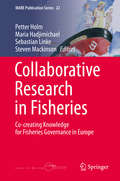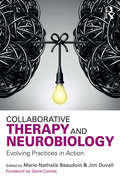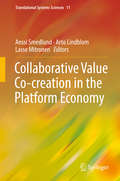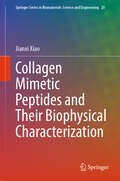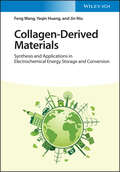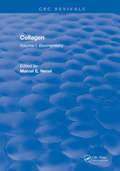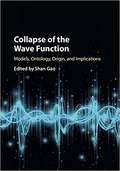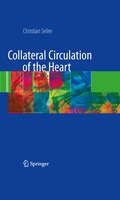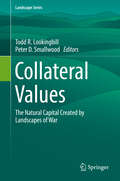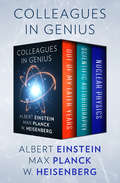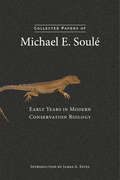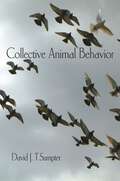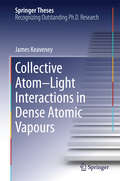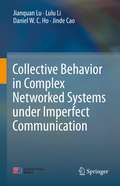- Table View
- List View
Collaborative Policing: Police, Academics, Professionals, and Communities Working Together for Education, Training, and Program Implementation (Advances in Police Theory and Practice)
by Peter C. Kratcoski Maximilian Edelbacher"The chapters in this book reveal that police education, training, and practices are now closely tied to collaboration between police, academics, professional practitioners, and community agencies, and such collaboration is described and evaluated." Dilip K. Das, PhD, Founding President, International Police Executive Symposium (IPES) and founding
Collaborative Research in Fisheries: Co-creating Knowledge for Fisheries Governance in Europe (MARE Publication Series #22)
by Sebastian Linke Petter Holm Maria Hadjimichael Steven MackinsonThis book is about the ongoing transition of fisheries governance, from top-down command and control towards a more transparent and participatory form. It focuses on the emergence of research practices and advice frameworks that allow co-creation of common knowledge bases for management. Drawing from 8 years of research in GAP, a two-stage 7th framework EU project, the book offers a critical examination of how knowledge practices in fisheries governance are changing. The entry point for this research is a series of practical experiments in the unchartered terrain of collaborative research. To gain insight into the ongoing transition in European fisheries management, GAP initiated and carried out 13 Case Studies in different settings across Europe. In each case study, a team of fishers and marine scientists worked together to identify, plan and implement research projects intended to make a difference. The cases vary. They take on different management issues and shape the collaborations in different ways. The extent to which they succeed in realizing their objectives also differs. They are all contributing important insights into the possibilities of co-creating knowledge for management purposes. The book delves into the individual experiences of each case study as well as the lessons they contribute as a whole. The examination concludes that while research partnerships are not always easy to establish, they are an important step towards better fisheries governance. Without a common knowledge base for fisheries governance, co-created through collaborative research practices, sustainable fisheries will remain out of reach.
Collaborative Therapy and Neurobiology: Evolving Practices in Action
by Jim Duvall Marie-Nathalie BeaudoinCollaborative Therapy and Neurobiology is the book many clinicians have been waiting for: an integration of twenty years of scientific and therapeutic cutting-edge ideas into concrete clinical practices. Interpersonal neurobiology and the development of exciting new technologies that allow us to better understand the brain have provided us with an enriched perspective on human experience. Yet, many clinicians wonder how to use this knowledge, and how these discoveries can actually benefit their clients. In particular, what are the concrete practices that each field uses to help clients overcome the issues in their lives, and how can these fields build on each other’s ideas? Could minimally developed concepts in each field be combined into innovative and powerful practices to foster client wellbeing? This book offers a collection of writings which provide theoretical food for thought, research evidence, and most importantly hands-on, concrete clinical ideas to enrich therapists’ work with a variety of clients. Illustrated with numerous transcripts of conversations and clinical stories, the ideas in this book will stimulate the work of people interested in renewing their practice with new ideas.
Collaborative Value Co-creation in the Platform Economy (Translational Systems Sciences #11)
by Anssi Smedlund Arto Lindblom Lasse MitronenThis book offers a service science perspective on platform orchestration and on collaborative consumption, providing an overview of research topics related to service dominant logic in multi-sided markets. The chapters give an international and multi-disciplinary overview of the current topics of digital service platforms from many angles. This overview helps in filling the gap between service science and recent research of the platform economy and paves the way for future service platform research. Open standards and distributed databases such as blockchain configurations increase the connectivity of business ecosystems as devices and systems exchange data with each other instead of through intermediaries. This exchange opens up opportunities for new value constellations, makes services globally scalable, and connects local service systems as integrated systems of systems. The book brings together established academics from a number of disciplines. This collaboration makes it possible to provide novel constructs and empirical results that help the reader to understand how value is co-created and orchestrated in the era of digital service platforms. In addition to theory building, practical implications for wider managerial and policy use are highlighted. The topics in this book are related to service platform technologies; organizational capabilities; and strategies and management in the contexts of retail, healthcare, and the public sector. A wide selection of case studies is used to demonstrate the implications of platforms for different service and economic contexts. Combining both theory and practice, this book is highly recommended for readers interested in the service and marketing point of view on the platform economy and for practitioners strategizing for scalable service platforms.Chapters 4 and 10 are available open access under a Creative Commons Attribution 4.0 International License via link.springer.com.
Collagen Biografts for Tunable Drug Delivery (SpringerBriefs in Applied Sciences and Technology)
by Rucha JoshiThis book reviews collagen-based biomaterials that have been applied broadly to tissue engineering and local drug delivery applications and lays out a landscape for developing a multifunctional biograft material from collagen polymers. The book also discusses current shortcomings in collagen based drug delivery opportunities, including poor mechanical properties, rapid proteolytic degradation, and cursory control over physical properties and molecular release profiles. Finally, a review of application of the collagen biograft materials for promoting neovascularization and tissue regeneration is presented, using examples of established in-vivo chicken egg chorioallantoic membrane (CAM) model. Use of heparin for affinity-based vascular endothelial growth factor (VEGF) retention in collagen constructs is also discussed for promoting neovascularization.Reviews state-of-the-art strategies for drug incorporation and retention in collagen; Covers collagen based material applications for improving vascularization and tissue regeneration; Illustrates how to tailor collagen architecture for soft tissue engineering and controlled drug delivery.
Collagen Mimetic Peptides and Their Biophysical Characterization (Springer Series in Biomaterials Science and Engineering #20)
by Jianxi XiaoThis book embarks on an enlightening journey through the molecular landscape of collagen mimic peptides, shedding light on their significance and potential. In the intricate realm of biomolecules, collagen's preeminence as the most abundant protein in the human body, forming the foundational scaffolding of tissues and organs, renders it a subject of profound scientific interest. It explores diverse facets related to collagen mimic peptides, spanning aspects such as bioinformatic analysis, synthetic strategies, pathological collagen targeting, and the construction of homotrimeric, heterotrimeric and self-assembled peptide models. Furthermore, it provides an exhaustive investigation into biophysical techniques, encompassing Circular Dichroism (CD), X-ray crystallography, Nuclear Magnetic Resonance (NMR), Fluorescence, and Raman spectroscopy, thereby empowering researchers to unravel the structural intricacies of these peptides. The book unravels the profound implications of collagen mimic peptides across a spectrum of scientific domains, including protein science, biomaterials, bioanalysis, and beyond. Its accessibility and insights cater not only to seasoned researchers but also to undergraduate and graduate students eager to delve into the complexities of this fundamental protein.
Collagen-Based Biotextiles for Tissue Engineering
by Fan Zhang Martin W. King Tushar Bambharoliya Ting He Daxian Zha Yihan Huang Monica Vijay Deshpande Jiyang ChenBased on the author's extensive research experience in collagen textiles and tissue engineering, this book presents a comprehensive introduction and guidelines for engineering artificial tissue using collagen-based fibrous material as a therapeutic candidate for regenerative medicine. The book covers different aspects of fibrous collagen material, including its chemistry, sourcing, fabrication, and applications in tissue engineering and regenerative medicine. Collagen-Based Biotextiles for Tissue Engineering provides a state-of-the-art overview of fibrous collagen-based materials and their application in tissue engineering and regenerative medicine for academic researchers, material scientists, and bioengineers.
Collagen-Derived Materials: Synthesis and Applications in Electrochemical Energy Storage and Conversion
by Feng Wang Yaqin Huang Jin Niu>Collagen-Derived Materials Comprehensive Resource for Current Ideas and Strategies for the Synthesis and Characterization of Advanced Collagen-Derived Materials This book presents and summarizes new synthetic strategies and multi-functional applications of collagen-derived materials in electrochemical energy storage and conversion. Through easily-comprehensible illustrations and images, the book presents basic knowledge for collagen-derived materials (including gelatin and collagen-derived carbons) and their typical synthesis and applications, thus enabling students and new researchers to obtain a thorough understanding of different materials and corresponding application areas. This book also serves as an important reference book for scientists and engineers in different research fields. It presents the up-to-date ideas and strategies for the synthesis and characterization of advanced collagen-derived materials, as well as multi-functional applications (especially in energy-related areas). Sample topics covered within the book include: Structural compositions, properties, and extraction of collagen and gelatin Precursors, structural compositions, and synthesis of collagen-derived carbons Applications of collagen-derived materials in electrochemical energy storage and conversion Applications of collagen-derived materials as electrode and supporting materials in the electrochemical energy storage and conversion systems, including capacitors, batteries, and electrocatalysts Challenges and opportunities for the design and synthesis of different collagen-derived materials For electrochemists, materials scientists, chemical engineers and students in related programs of study who are interested in the topic of collagen-derived materials, Collagen-Derived Materials: Synthesis and Applications in Electrochemical Energy Storage and Conversion serves as an important resource for gaining a holistic understanding of the field and learning about the state of the art based on promising energy-related applications.
Collagen: Methods and Protocols (Methods in Molecular Biology #1944)
by Irit Sagi Nikolaos A. AfratisThis detailed volume compiles state-of-the-art protocols that will serve as recipes for scientists researching collagen, an abundant protein with great importance to health and disease, as well as in applications like food, cosmetics, pharmaceuticals, cosmetic surgery, artificial skin, and glue. Beginning with a section on in vitro models for the characterization of collagen formation, the book continues by highlighting large-scale analysis of collagen with mass spectrometry in order to elucidate the proteomics, degradomics, interactomes, and cross-linking of collagen, high resolution imaging approaches for collagen by the use of scanning electron microscopy and multiphoton imaging, as well as the role of collagen during physiological and pathological conditions. Written for the highly successful Methods in Molecular Biology series, chapters include introductions to their respective topics, lists of the necessary materials and reagents, step-by-step, readily reproducible laboratory protocols, and tips on troubleshooting and avoiding known pitfalls. Authoritative and practical, Collagen: Methods and Protocols is an ideal guide to high quality and repeatable protocols in this vital field of study.
Collagen: Volume I: Biochemistry
by Marcel E. NimniThis series was conceived with the idea of integrating current aspects of ongoing research in the collagen field. The book consists of a spectrum of papers which discus divers aspects such as X-ray structure, the thermodynamics and mechanism of fibrillogenesis, and the use of collagen as a biomaterial for the manufacturing of many implantable, sometimes lifesaving, devises.
Collapse of Metastability: Dynamics of First-Order Phase Transition (Fundamental Theories of Physics #211)
by Seiji MiyashitaTo understand phenomena in nature, it is important to focus not only on properties of stationary states, but also their changes in time, that is, the dynamics between bistable states. This book reviews the mechanics of first-order phase transitions and discusses relaxation and collapses of metastable states from various viewpoints, including Kramers' method for the lifetime of metastability, Langer’s analysis on the singularity, effects of thermal fluctuation studied by Néel and Brown, and eigenvalue structures of the transfer-matrix for the phase transitions. The book also goes into the mechanics of metastability in quantum systems from the viewpoints of the eigenvalue problem of the Hamiltonian and the Liouvillian for a dynamical process and discusses relations between quantum tunneling processes and metastability therein. Lastly, the coercivity of magnets consisting of an ensemble of grains is reviewed. The book is beneficial for those new in the field as a primer on first-order phase transition from modern perspectives. The comprehensive content offers overviews of related topics and allows readers to quickly catch up with developments in the field.
Collapse of the Wave Function: Models, Ontology, Origin, and Implications
by Shan GaoThis is the first single volume about the collapse theories of quantum mechanics, which is becoming a very active field of research in both physics and philosophy. In standard quantum mechanics, it is postulated that when the wave function of a quantum system is measured, it no longer follows the Schrödinger equation, but instantaneously and randomly collapses to one of the wave functions that correspond to definite measurement results. However, why and how a definite measurement result appears is unknown. A promising solution to this problem are collapse theories in which the collapse of the wave function is spontaneous and dynamical. Chapters written by distinguished physicists and philosophers of physics discuss the origin and implications of wave-function collapse, the controversies around collapse models and their ontologies, and new arguments for the reality of wave function collapse. This is an invaluable resource for students and researchers interested in the philosophy of physics and foundations of quantum mechanics.
Collapsing Gracefully: Making a Built Environment that is Fit for the Future
by Robert Vale Brenda Vale Emilio GarciaThis innovative book investigates the concept of collapse in terms of our built environment, exploring the future transition of modern cities towards scenarios very different from the current promises of progress and development. This is not a book about the end of the world and hopeless apocalyptic scenarios. It is about understanding change in how and where we live. Collapse is inevitable, but in the built environment collapse could imply a manageable situation, an opportunity for change or a devastating reality. Collapsing gracefully means that there might be better ways to coexist with collapse if we learn more about it and commit to rebuild our civilisations in ways that avoid its worst effects. This book uses a wide range of practical examples to study critical changes in the built environment, to contextualise and visualise what collapse looks like, to see if it is possible to buffer its effects in places already collapsing and to propose ways to develop greater resilience.The book challenges all agents and institutions in modern cities, their designers and planners as well as their residents and users to think differently about built environment so as to ease our coexistence with collapse and not contribute to its causes. .
Collateral Circulation of the Heart
by Christian SeilerThe focus of this title is on practical aspects of human coronary collateral vessels. However, basic science and pathophysiological aspects should also be covered in every chapter as without this knowledge, clinical aspects cannot be fully understood. Each chapter will be divided into a more practical part ("at a glance") and into a "full picture" part. The number of pages would be between 400 and 500 and highly illustrated. The imaging chapters will be well illustrated with examples of angiogenesis and collateral vessels via all the relevant imaging modalities.
Collateral Values: The Natural Capital Created by Landscapes of War (Landscape Series #25)
by Todd R. Lookingbill Peter D. SmallwoodThis book explores the unanticipated benefits that may arise after wars and conflicts, showing how the preservation of battlefields and the establishment of borderlands can create natural capital in the former landscapes of war. The editors call this Collateral Value, in contrast to the collateral damage that war inflicts upon infrastructure, natural capital, and human capital. The book includes case studies recounting successes and failures, opportunities and risks, and ambitious proposals. The book is organized in two sections. The first visits U.S., English, and French battlefield sites dating from medieval England to World War I. The second explores borderlands located on several continents, established to end or prevent conflict. Both of these can create value beyond their original purpose, by preserving natural areas and restoring biodiversity. Among the topics covered are: · Registering English Battlefields · Old forts and new amenities in the Southern Plains of the U.S. · Verdun, France, and the conservation of WWI cultural and natural heritage · Conservation lessons learned in the Cordillera del Condor Corridor of the Andes mountains · Korea’s DMZ and its nature preserve · Wakhan National Park, a mountainous buffer area between Afghanistan and Pakistan The book examines state-of-the-art applications of landscape ecology, including methods for change detection, connectivity analysis, and the quantification of ecosystem services. Also included is a chapter on a creative proposal for “Guantánamo 2.0,” which would transform the Gitmo detention facility into a peace park and ecological research center. A concluding chapter appraises the past, present, and future of Collateral Values.Collateral Values: The Natural Capital Created by Landscapes of War benefits a broad audience of advanced undergraduate and graduate students, researchers, and practicing professionals.
Colleagues in Genius: Out of My Later Years, Scientific Autobiography, and Nuclear Physics
by Albert Einstein W. Heisenberg Max PlanckThese three works by Nobel Prize–winning physicists offer an enlightening window into the scientific minds that changed the twentieth century. With their discoveries and formulations, Albert Einstein, Max Planck, and Werner Heisenberg ushered the world into the Nuclear Age. As colleagues, they often corresponded, sharing insights and championing each other&’s work. In the three volumes collected here, they discuss their thoughts about life, science, politics, and how they approached their revolutionary work. Out of My Later Years by Albert Einstein: Perhaps the most celebrated scientist of the twentieth century, Albert Einstein was also a philosopher and outspoken humanitarian. Collected here are some of his most insightful essays, articles, letters, and speeches written between 1934 and 1950. Accessible and fascinating, these works reflect the broad sweep of Einstein&’s intellectual concerns, from scientific inquiry to Jewish identity; and from global politics to the great minds he knew and admired. Scientific Autobiography by Max Planck: The founder of quantum theory, Max Planck revolutionized our understanding of atomic and subatomic behavior. Born in Germany in 1858, he lived a long and eventful life at the center of both scientific advancement and global events. From the childhood epiphany that inspired him to pursue a life in science, to the great discoveries he made amidst terrifying political turmoil, Planck tells his story in this illuminating autobiography. Nuclear Physics by W. Heisenberg: Werner Heisenberg is famous for developing the uncertainty principle, which bears his name, and for his pioneering work in quantum mechanics. In Nuclear Physics, he offers an accessible introduction to the subject based on his own lectures. Beginning with a short history of atomic physics, he delves into the nature of nuclear forces and reactions, the tools of nuclear physics, and its world-changing technical and practical applications.
Collected Papers of Michael E. Soulé: Early Years in Modern Conservation Biology
by Michael E. SouléIn the early 1970s, the environmental movement was underway. Overpopulation was recognized as a threat to human well-being, and scientists like Michael Soulé believed there was a connection between anthropogenic pressures on natural resources and the loss of the planet's biodiversity. Soulé--thinker, philosopher, teacher, mentor, and scientist--recognized the importance of a healthy natural world and with other leaders of the day pushed for a new interdisciplinary approach to preserving biological diversity. Thirty years later, Soulé is hailed by many as the single most important force in the development of the modern science of conservation biology. This book is a select collection of seminal writings by Michael Soulé over a thirty-year time-span from 1980 through the present day. Previously published in books and leading journals, these carefully selected pieces show the progression of his intellectual thinking on topics such as genetics, ecology, evolutionary biology, and extinctions, and how the history and substance of the field of conservation biology evolved over time. It opens with an in-depth introduction by marine conservation biologist James Estes, a long-time colleague of Soulé's, who explains why Soulé's special combination of science and leadership was the catalyst for bringing about the modern era of conservation biology. Estes offers a thoughtful commentary on the challenges that lie ahead for the young discipline in the face of climate change, increasing species extinctions, and impassioned debate within the conservation community itself over the best path forward. Intended for a new generation of students, this book offers a fresh presentation of goals of conservation biology, and inspiration and guidance for the global biodiversity crises facing us today. Readers will come away with an understanding of the science, passion, idealism, and sense of urgency that drove early founders of conservation biology like Michael Soulé.
Collected Wisdom of the Early Modern Scholar: Essays in Honor of Mordechai Feingold (Archimedes #64)
by Gideon Manning Anna Marie RoosThis book brings together leading scholars in the history of science, history of universities, intellectual history, and the history of the Royal Society, to honor Professor Mordechai Feingold. The essays collected here reflect the impact Feingold's scholarship has had on a range of fields and address several topics, including: the dynamic pedagogical techniques employed in early modern universities, networks of communication through which scientific knowledge was shared, experimental techniques and knowledge production, the life and times of Isaac Newton, Newton's reception, and the scientific culture of the Royal Society. Modeling the interdisciplinary approaches championed by Feingold as well as the essential role of archival studies, the volume attests to the enduring value of his scholarship and sets a benchmark for future work in the history of science and its allied fields.
Collecting Experiments: Making Big Data Biology
by Bruno J. StrasserDatabases have revolutionized nearly every aspect of our lives. Information of all sorts is being collected on a massive scale, from Google to Facebook and well beyond. But as the amount of information in databases explodes, we are forced to reassess our ideas about what knowledge is, how it is produced, to whom it belongs, and who can be credited for producing it. Every scientist working today draws on databases to produce scientific knowledge. Databases have become more common than microscopes, voltmeters, and test tubes, and the increasing amount of data has led to major changes in research practices and profound reflections on the proper professional roles of data producers, collectors, curators, and analysts. Collecting Experiments traces the development and use of data collections, especially in the experimental life sciences, from the early twentieth century to the present. It shows that the current revolution is best understood as the coming together of two older ways of knowing—collecting and experimenting, the museum and the laboratory. Ultimately, Bruno J. Strasser argues that by serving as knowledge repositories, as well as indispensable tools for producing new knowledge, these databases function as digital museums for the twenty-first century.
Collection Care: Environmental Monitoring, Risk Assessment and Risk Management (Springer Proceedings in Archaeology and Heritage)
by Ángel F. Perles-Ivars Laura Fuster-López Emanuela BoscoThis open access book compiles the contributions of the conference Collection Care: New Challenges in Environmental Monitoring, Risk Assessment and Risk Management. The conference held within the framework of the EU&’s Horizon2020 CollectionCare project (grant no. 814624), was a forum where the latest technological advances in the study of the behavior and aging of cultural heritage materials, environmental monitoring, and the design of preventive conservation strategies in collections were presented. This volume is of interest to heritage researchers and is divided into two sections: the first brings together thirteeen papers that focus on the monitoring, analysis, data interpretation and modelling of the effects of different degradation agents (temperature, relative humidity, pollutants, light, vibration, etc.) in materials present in cultural heritage objects. The second part of the book presents eight case studies dealing with risk assessment and risk management in different types of collections with diverse needs, priorities, and resources, thus illustrating the complexity of implementing all the current knowledge on sensing, monitoring, predictive analysis and preventive conservation in the design of conservation strategies. The case studies presented also demonstrate how these tools have contributed to maximise dialogue and coordination between the different stakeholders involved in the conservation of cultural heritage.
Collective Action and Exchange: A Game-Theoretic Approach to Contemporary Political Economy
by William D. FergusonIn Collective Action and Exchange: A Game-Theoretic Approach to Contemporary Political Economy, William D. Ferguson presents a comprehensive political economy text aimed at advanced undergraduates in economics and graduate students in the social sciences. The text utilizes collective action as a unifying concept, arguing that collective-action problems lie at the foundation of market success, market failure, economic development, and the motivations for policy. Ferguson draws on information economics, social preference theory, cognition theory, institutional economics, as well as political and policy theory to develop this approach. The text uses classical, evolutionary, and epistemic game theory, along with basic social network analysis, as modeling frameworks. These models effectively bind the ideas presented, generating a coherent theoretic approach to political economy that stresses sometimes overlooked implications.
Collective Animal Behavior
by David J. SumpterHow and why animals produce group behaviorsFish travel in schools, birds migrate in flocks, honeybees swarm, and ants build trails. How and why do these collective behaviors occur? Exploring how coordinated group patterns emerge from individual interactions, Collective Animal Behavior reveals why animals produce group behaviors and examines their evolution across a range of species.Providing a synthesis of mathematical modeling, theoretical biology, and experimental work, David Sumpter investigates how animals move and arrive together, how they transfer information, how they make decisions and synchronize their activities, and how they build collective structures. Sumpter constructs a unified appreciation of how different group-living species coordinate their behaviors and why natural selection has produced these groups. For the first time, the book combines traditional approaches to behavioral ecology with ideas about self-organization and complex systems from physics and mathematics. Sumpter offers a guide for working with key models in this area along with case studies of their application, and he shows how ideas about animal behavior can be applied to understanding human social behavior.Containing a wealth of accessible examples as well as qualitative and quantitative features, Collective Animal Behavior will interest behavioral ecologists and all scientists studying complex systems.
Collective Atom-Light Interactions in Dense Atomic Vapours (Springer Theses)
by James KeaveneyThe propagation of light in 'dense media' where dipole-dipole interactions play a role is a fundamental topic that was first studied in the work of Clausius, Mossotti, Lorenz and Lorentz in the latter half of the nineteenth century. However, until recently there remained some areas of controversy: for example, whereas the Lorentz model for a gas predicts a resonance shift, a discrete dipole model does not. This thesis makes the first combined measurement of both the Lorentz shift and the associated collective Lamb shift. This clear experimental result stimulated new theoretical work that has significantly advanced our understanding of light propagation in interacting media.
Collective Behavior in Complex Networked Systems under Imperfect Communication
by Jinde Cao Jianquan Lu Lulu Li Daniel W.C. HoThis book aims to explain how collective behavior is formed via local interactions under imperfect communication in complex networked systems. It also presents some new distributed protocols or algorithms for complex networked systems to comply with bandwidth limitation and tolerate communication delays. This book will be of particular interest to the readers due to the benefits: 1) it studies the effect of time delay and quantization on the collective behavior by non-smooth analytical technique and algebraic graph theory; 2) it introduces the event-based consensus method under delayed information transmission; In the meantime, it presents some novel approaches to handle the communication constraints in networked systems; 3) it gives some synchronization and control strategies for complex networked systems with limited communication abilities. Furthermore, it provides a consensus recovery approach for multi-agent systems with node failure. Also, it presents interesting results about bipartite consensus and fixed-time/finite-time bipartite consensus of networks with cooperative and antagonistic interactions.

